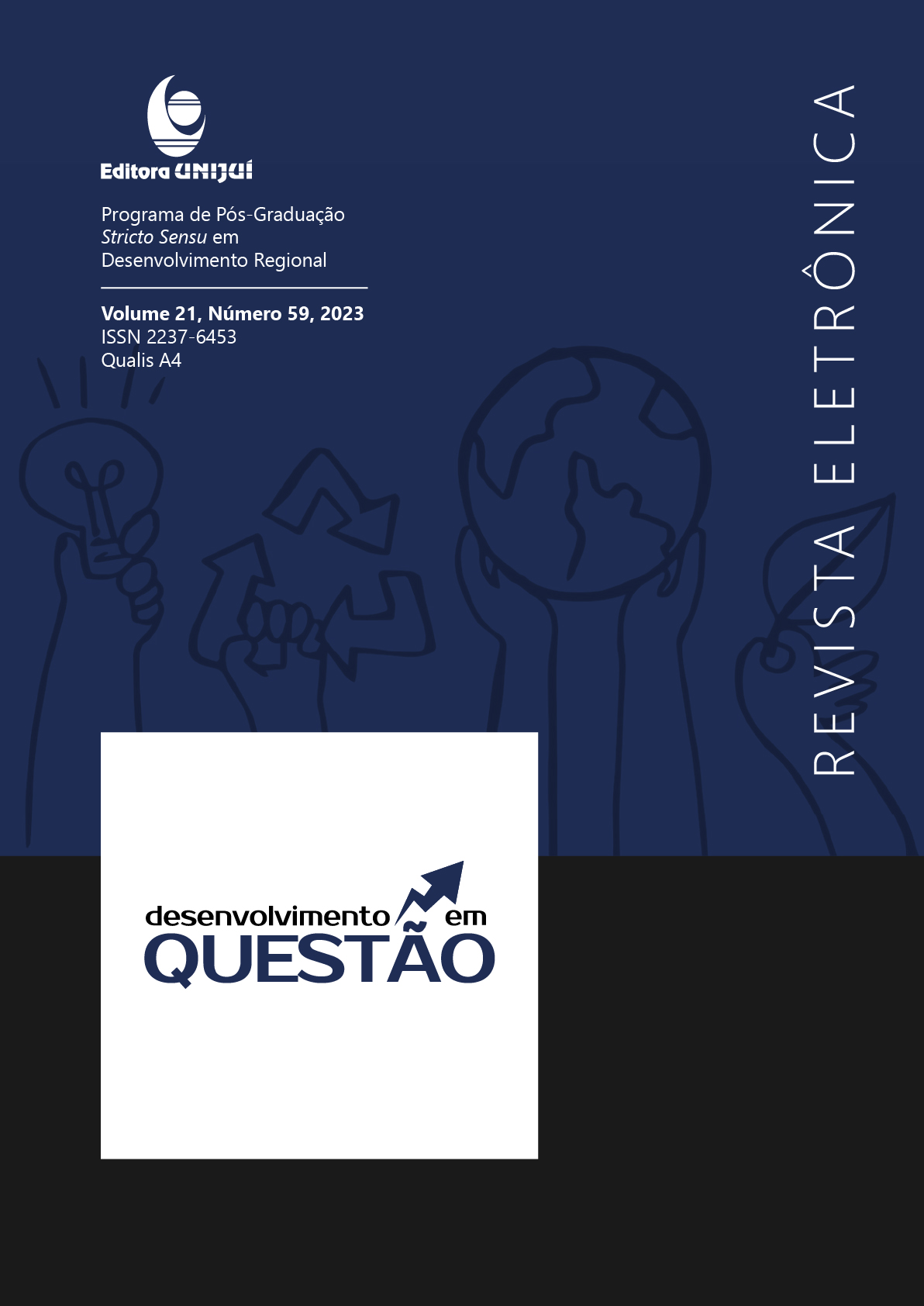The north-south railway and its influence on the economic performance of municipalities in Goiás
DOI:
https://doi.org/10.21527/2237-6453.2023.59.13112Keywords:
Ferrovia Norte-Sul, Desempenho Econômico, Municípios GoianosAbstract
The objective of this article is to analyze the influence of the North-South Railway on the performance of municipalities in Goiás between the years 2007-2017, based on the hypothesis that there may be a positive relationship between the transport network and regional and economic development. place. Therefore, the methodology used involved the study of theoretical and empirical bibliography with a historical review of the transport infrastructure in the central region of the country, with emphasis on the North-South Railway, its location and influence on the logistics of the State of Goiás. Econometric analyzes were also carried out with the objective of verifying the changes in the municipal variables:gross domestic product per capita, average worker remuneration, formal employment and tax revenue, from the construction and operation of the North-South Railway in the Goiás territory. The empirical result indicated that despite the railways promoting a better performance for the economy, their construction alone is not enough to promote the economic growth of municipalities, including Goiás, as indicated by the results of the estimated models. It was concluded, therefore, that the articulated action of the modes of transport, operators, customers and public policies is also necessary for the realization of the purposes of integration and development that the North-South Railway could provide.
References
BARROS, A. R. Análise dos impactos socioeconômicos da instalação da Ferrovia Norte Sul nos municípios de Colinas do Tocantins e Palmeirante. 2008. Dissertação (Mestrado Profissional em Ciências do Ambiente e Sustentabilidade na Amazônia) – Universidade Federal do Amazonas, Manaus, 2008.
BRASIL. PAC, Programa de Aceleração do Crescimento. Disponível em: http://pac.gov.br/sobre-o-pac. Acesso em: 26 jul. 2020.
CAMPOS, F. R. A influência da Ferrovia Norte-Sul no desenvolvimento regional do território goiano. 2015. 258 f. Tese (Doutorado em Geografia) – Universidade Federal de Goiás, Goiânia, 2015.
CASTILHO, D.; ARRAIS, T. A. A Ferrovia Norte-Sul e a economia regional do Centro-Norte do Brasil. Revista Sociedade & Natureza, v. 29, n. 2, p. 209-228, 2017.
CEPEA. Pib do agronegócio brasileiro. Disponível em: https://www.cepea.esalq.usp.br/br/pib-do-agronegocio-brasileiro.aspx. Acesso em: 25 abr. 2020.
FOGEL, M. Diferenças em diferenças. In: Avaliação econômica de projetos sociais. 3. ed. São Paulo: Fundação Itaú Social, 2017. p. 150-170.
FONSECA, S. B. J.; ROMANATTO, E. Agropecuária goiana: uma análise em perspectiva histórica – fevereiro/2017. Estudos IMB. Disponível em: https://www.imb.go.gov.br. Acesso em: 20 jul. 2020.
GALVÃO, O. J. A. Desenvolvimento dos transportes e integração regional no Brasil – uma perspectiva histórica. Planejamento e Políticas Públicas, n. 13, p. 183-214, jun. 1996.
HARVEY, D. Cidades rebeldes: do direito à cidade à revolução urbana. São Paulo: Martins Fontes, 2014.
HIRSCHMAN, Albert Otto. Estratégia do desenvolvimento econômico. Rio de Janeiro: Fundo de Cultura, 1961.
HOLANDA, S. B. Raízes do Brasil. 27. ed. São Paulo: Companhia das Letras, 2014.
IMB. Instituto Mauro Borges de Estatística e Estudos Geoeconômicos. Estatísticas municipais (Séries históricas). Disponível em: http://www.imb.go.gov.br/bde/. Acesso em: 21 out. 2019.
IMB. Instituto Mauro Borges de Estatística e Estudos Geoeconômicos. Goiás – visão geral. Disponível em: https://www.imb.go.gov.br/index.php?option=com_content&view=article&id=79&Itemid=145. Acesso em: 25 abr. 2020.
IPEA. Instituto de Pesquisa Econômica Aplicada – Ipeadata. Dados macroeconômicos e regionais. Disponível em: http://www.ipeadata.gov.br. Acesso em: 21 out. 2019.
IPEA. Instituto de Pesquisa Econômica Aplicada. Carta de conjuntura. Disponível em: http://www.ipea.gov.br/cartadeconjuntura/wp-content/uploads/2020/02/CC46-Economia-Agr%C3%ADcola-Final-V.pdf. Acesso em: 21 out. 2019.
MARTINS, V. L. F. D.; PARREIRA, K. M.; VIEIRA, J. C. A importância da infraestrutura de transporte para o desenvolvimento do Estado de Goiás. Revista Brasileira de Planejamento e Desenvolvimento. Curitiba, v. 6, n. 3, p. 427-444. 2017.
MYRDAL, Gunnar. Teoria econômica e regiões subdesenvolvidas. Lisboa: Editoria Saga, 1965.
PADULA, R. Transportes – Fundamentos e propostas para o Brasil. Brasília: Confea, 2008. Disponível em: http://www.confea.org.br/media/Livro_Transportes.pdf. Acesso em: 26 jul. 2020.
PIRES, M. J. de S. Transportes e desenvolvimento agrícola no Centro-Oeste. 2000. Dissertação (Mestrado) – Unicamp, Instituto de Economia da Universidade Estadual de Campinas, Campinas, 2000.
PIRES, M. J. S.; CAMPOS, F. R. Contribuições das Ferrovias Norte-Sul e Centro-Atlântica na expansão do Vetor Externo da Economia do Centro-Oeste. Revista de Economia do Nordeste, Fortaleza, v. 50, n. 4, p. 129-147, 2019.
RAIS. Relação Anual de Informações. Disponível em: http://bi.mte.gov.br/bgcaged/login.php. Acesso em: 2 mar. 2020.
RIBEIRO, J. C. A. et al. Impactos socioeconômicos da implantação da Ferrovia Norte-Sul em Uruaçu-GO: perspectivas e possibilidades. Brazilian Journal of Development. Curitiba, v. 7, n. 5, p. 46.816-46.836, maio 2021.
ROCHA, F. V. da; CAIXETA FILHO, J. V. Ferrogrão: impactos econômicos e a localização ótima do terminal de transbordo. Pesquisa Operacional para o Desenvolvimento. Rio de Janeiro, v. 10, n. 2, p. 108-127, out. 2018.
ROZAS, P.; SÁNCHEZ, R. Desarrollo de infraestructura y crecimiento económico: revisión conceptual. Santiago: Nações Unidas, 2004. (Série recursos naturales e infraestructura, n. 75).
VALEC. Engenharia, Construções e Ferrovias S.A. Disponível em: www.valec.gov.br. Acesso em: 21 abr. 2020.
Downloads
Published
How to Cite
Issue
Section
License
Copyright (c) 2023 Desenvolvimento em Questão

This work is licensed under a Creative Commons Attribution 4.0 International License.
By publishing in Revista Desenvolvimento em Questão, authors agree to the following terms:
All works are published under the Creative Commons Attribution 4.0 International License (CC BY 4.0), which allows:
Sharing — to copy and redistribute the material in any medium or format;
Adaptation — to remix, transform, and build upon the material for any purpose, even commercially.
These permissions are irrevocable, provided that the following terms are respected:
Attribution — authors must be properly credited, a link to the license must be provided, and any changes made must be indicated.
No additional restrictions — no legal or technological measures may be applied that legally restrict others from doing anything the license permits.
Notices:
The license does not apply to elements that are in the public domain or covered by legal exceptions.
The license does not grant all necessary rights for specific uses (e.g., image rights, privacy, or moral rights).
The journal is not responsible for the opinions expressed in the articles, which are the sole responsibility of the authors. The Editor, with the support of the Editorial Board, reserves the right to suggest or request modifications when necessary.
Only original scientific articles presenting research results of interest that have not been previously published or simultaneously submitted to another journal with the same purpose will be accepted.
Mentions of trademarks or specific products are intended solely for identification purposes and do not imply any promotional relationship by the authors or the journal.
License Agreement (for articles published from 2025 onward): Authors retain the copyright to their article and grant Revista Desenvolvimento em Questão the right of first publication.











